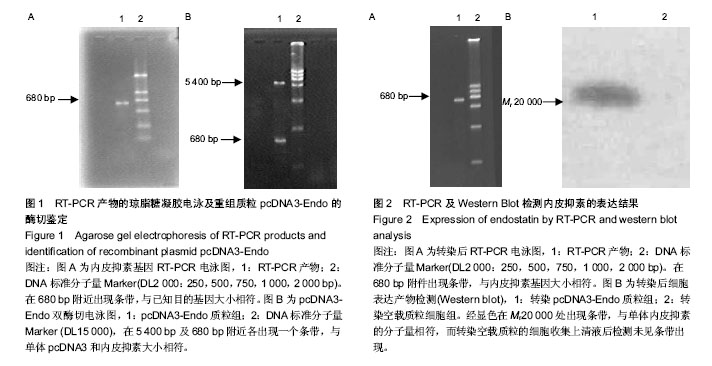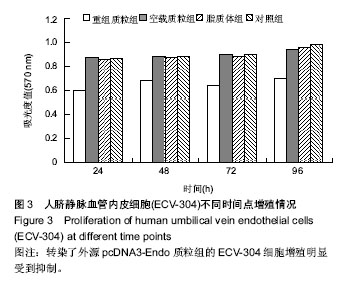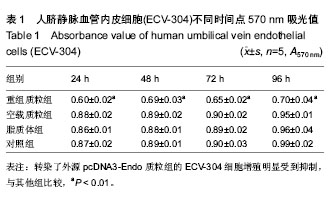| [1] Prudovsky I. Nonclassically Secreted Regulators of Angiogenesis. Angiol Open Access.2013;28;1(1):1000101.
[2] Leung WY, Jensen MB. Histological Quantification of Angiogenesis after Focal Cerebral Infarction: A Systematic Review.ISRN Neurol.2013;30:853737.
[3] Finn NA, Searles CD.Intracellular and Extracellular miRNAs in Regulation of Angiogenesis Signaling.Curr Angiogenes. 2012;4(102):299-307.
[4] Dharmalingam P, Roopesh Kumar VR, Verma SK. Vascular endothelial growth factor expression and angiogenesis in various grades and subtypes of meningioma. Indian J Pathol Microbiol.2013;56(4):349-54.
[5] O'Reilly MS, Boehm T, Shing Y, et al.Endostatin: An endogenous inhibitor of angiogenesis and tumor growth. Cell. 1997;88(2):277-285.
[6] Ma X, Yao Y, Yuan D,et al.Recombinant human endostatin endostar suppresses angiogenesis and lymphangiogenesis of malignant pleural effusion in mice. PLoS One. 2012;7(12): e53449.
[7] Fu Y, Tang H, Huang Y,et al.Unraveling the mysteries of endostatin.IUBMB Life. 2009;61(6):613-626.
[8] Bai YJ, Huang LZ, Zhou AY, et al.Antiangiogenesis effects of endostatin in retinal neovascularization.J Ocul Pharmacol Ther.2013;29(7):619-626.
[9] 邢承忠,洪晶,顾绍峰,等.兔骨髓间充质干细胞的分离、培养和鉴定[J].中国医科大学学报,2008,3(1):4-5.
[10] Folkman J.Angiogenesis in cancer,cascular,rheumatoid and other disease.Nat med.1995;1:27-31.
[11] Zatterstrom UK,Felbor U,Fukai N, et al.Collagen XVIII/endostatin structure and functional role in angiogenesis. Cell Struct Funct.2000;25(2):97-101.
[12] Hohenester E,Sasaki T,Mann K,et al.Variable zinc coordination in endostatin. J Mol Biol. 2000;297(1):1-6.
[13] Miosge N,Sasaki T,Timpl R,et al.Angiogenesis inhibitor endostatin is a distinct component of elastic fibers in vessel walls.FASEB J.1999;13(13):1743-1750.
[14] Ding,YH,Javaherian K,Chopra R,Boehm T, et al. Zinc-dependant dimersobserved in crystals of human endostatin. Proc Natl Sc i.1998;95(18):10443-10448.
[15] Yamaguchi N,Lee M,Sasaki T,et al.Endostatin inhibits VEGF-induced endothelial cell migration and tumor growth in dependently of zinc binding.EMBO J.1999;18(16): 4414-4423.
[16] Chu TQ, Ding H, Garfield DH,et al.Can determination of circulating endothelial cells and serum caspase-cleaved CK18 predict for response and survival in patients with advanced non-small-cell lung cancer receiving endostatin and paclitaxel-carboplatin chemotherapy? a retrospective study.J Thorac Oncol. 2012;7(12):1781-1789.
[17] Matsumoto G, Hirohata R, Hayashi K, et al.Control of angiogenesis by VEGF and endostatin-encapsulated protein microcrystals and inhibition of tumor angiogenesis. Biomaterials. 2014;35(4):1326-1333.
[18] Dong XP, Xiao TH, Dong H, et al.Endostar combined with cisplatin inhibits tumor growth and lymphatic metastasis of lewis lung carcinoma xenografts in mice. Asian Pac J Cancer Prev. 2013;14(5):3079-3083.
[19] Zhou J, Wang L, Xu X, et al.Antitumor activity of Endostar combined with radiation against human nasopharyngeal carcinoma in mouse xenograft models.Oncol Lett. 2012;4(5): 976-980.
[20] Ning TH, Chao CJ, Ying MG,et al.Preparation, characterization and anti-angiogenesis activity of endostatin covalently modified by polysulfated heparin.Pharmazie. 2012;67(7):622-627.
[21] Jia H, Li Y, Zhao T,et al.Antitumor effects of Stat3-siRNA and endostatin combined therapies, delivered by attenuated Salmonella, on orthotopically implanted hepatocarcinoma. Cancer Immunol Immunother. 2012;61(11):1977-87.
[22] Xu WJ, Huang C, Wang J,et al.Comparison of the effects of recombinant human endostatin and docetaxel on human umbilical vein endothelial cells in different growth states.Chin Med J (Engl). 2011;124(18):2883-2889.
[23] Jia Y, Liu M, Cao L,et al.Recombinant human endostatin, Endostar, enhances the effects of chemo-radiotherapy in a mouse cervical cancer xenograft model. Eur J Gynaecol Oncol. 2011;32(3):316-324.
[24] Folkman J. Antiangiogenesis in cancer therapy-endostatin and its mechanisms of action.Exp Cell Res. 2006;312(5):594-607.
[25] Blezinger P,Wang J,Gondo M,et al.Systemic inhibition of tumor growth and tumor metastases by intramuscular administration of the endostatin gene.Nat Biotechnol.1999; 17(4):343-349.
[26] Xu W,Ye P,Li Z,et,al.Endostar,a recently introduced recombinant human endostatin, inhibits proliferation and migration through regulating growth factors, adhesion factors and inflammatory mediators in choroid-retinal endothelial cells.Mol Biol(Mosk).2010;44(4):664-670.
[27] Li Y,Guo C,Wang Z,et al.Enhanced effects of TRAIL-endostatin-based double-gene-radiotherapy on suppressing growth, promoting apoptosis and inducing cell cycle arrest in vascular endothelial cells. J Huazhong Univ Sci Technolog Med Sci.2012;32(2):167-172.
[28] Wan YY,Tian GY,Guo HS,et al.Endostatin, an angiogenesis inhibitor, ameliorates bleomycin-induced pulmonary fibrosis in rats.Respir Res.2013;14(1):56.
[29] Wietecha MS, Cerny WL, DiPietro LA. Mechanisms of vessel regression: toward an understanding of the resolution of angiogenesis.Curr Top Microbiol Immunol. 2013;367:3-32.
[30] Kim YM,Young-Mi K,Jin-Wook J, et al.Endostatin inhibits endothelial and tumor cellular invasion by blocking the activation and catalytic of matrix metalloproteinase2.Cancer Res.2000;60:5410-5413.
[31] Kim YM,Hwang S, Kim YM, et al.Endostatin blocks vascular endothelial growth factor-mediated signaling via direct interaction with KDR/Flk-1.J Biol Chem. 2002;277(31): 27872-27879.
[32] Skovseth DK,Veuger MJ,Sorensen DR,et al.Endostatin dramatically inhibits endothelial cell migration, vascular morphogenesis, and perivascular cell recruitment in vivo.Blood.2005;105(3):1044-1051.
[33] Eriksson K,Magnusson P,Dixelius J,et al.Angiostatin and endostatin inhibit endothelial cell migration in response to FGF and VEGF without interfering with specific intracellular signal transduction pathways. FEBS Lett. 2003; 536(1-3): 19-24.
[34] O'Reilly T, Lane HA, Wood JM,et al.Everolimus and PTK/ZK show synergistic growth inhibition in the orthotopic BL16/BL6 murine melanoma model. Cancer Chemother Pharmacol. 2011;67(1):193-200.
[35] Isobe T, Onn A, O'Reilly MS,et al.Evaluation of novel orthotopic nude mouse models for human small-cell lung cancer.J Thorac Oncol. 2013;8(2):140-146.
[36] Sun BC,Zhang SW,Qi LS,et al.Study on the molecular mechanism of endostatin and doxycycline in suppressing melanoma growth.Zhonghua Bing Li Xue Za Zhi. 2006; 35(11):677-680.
[37] Jiang WG,Lu XA,Shang BY, et al.Genetically engineered endostatin-lidamycin fusion proteins effectively inhibit tumor growth and metastasis.BMC Cancer. 2013;15(13):479.
[38] Ren MH, Yu JS, Song EL,et al.Antitumor effects of mutant endostatin are enhanced by Bcl-2 antisense oligonucleotides in UM-UC-3 bladder cancer cell line. Chin Med J (Engl). 2013; 126(15):2834-2839.
[39] Shan YF, Fang YF, Wang XQ,et al.Experimental studies on treatment of pancreatic cancer with double-regulated duplicative adenovirus AdTPHre-hEndo carrying human endostatin gene.Pancreatology.2013;13(4):393-400.
[40] Yin Y, Kou L, Wang JJ, et al.Therapeutic efficacy of Bifidobacterium longum-mediated human interleukin-2 with endostatin or TRAIL in transplanted tumors in mice.Exp Ther Med.2012;3(3):481-486.
[41] Cao B,Jia J,Ma L,et al.Recombinant human endostatin could eliminate the pro-angiogenesis priority of SP cells sorted from non-small cell lung cancer cells. Clin Transl Oncol. 2012;14(8): 575-585.
[42] Al Ahmad A,Lee B,Stack J,et al.Endostatin binds nerve growth factor and thereby inhibits neurite outgrowth and neuronal migration in-vitro.Brain Res. 2010;1360:28-39.
[43] Schmidt A, Sommer F, Ozgür E,et al.Vessels in benign prostatic hyperplasia contain more binding sites for endostatin than vessels in normal prostate tissue. Eur Urol. 2004;46(6): 765-767.
[44] Benezra R,Rafii S.Endostatin's endpoints-Deciphering the endostatin antiangiogenic pathway.Cancer Cell. 2004;5(3): 205-206.
[45] Torres PH,Sousa GL, Pascutti PG.Structural analysis of the N-terminal fragment of the antiangiogenic protein endostatin: a moleculardynamics study.Proteins. 2011;79(9):2684-92.
[46] Bendrik C,Karlsson L,Dabrosin C.Increased endostatin generation and decreased angiogenesis via MMP-9 by tamoxifen in hormone dependent ovarian cancer. Cancer Lett.2010;292(1):32-40.
[47] Ou J, Li J, Pan F,et,al.Endostatin suppresses colorectal tumor-induced lymphangiogenesis by inhibiting expression of fibronectin extra domain A and integrin α9.J Cell Biochem. 2011;112(8):2106-2114.
[48] Faye C,Moreau C,Chautard E,et al.Molecular interplay between endostatin, integrins, and heparan sulfate.J Biol Chem. 2009;284(33):22029-40.
[49] Wickström SA, Alitalo K, Keski-Oja J.An endostatin-derived peptide interacts with integrins and regulates actin cytoskeleton and migration of endothelial cells.J Biol Chem. 2004;279(19):20178-20185. |



.jpg)